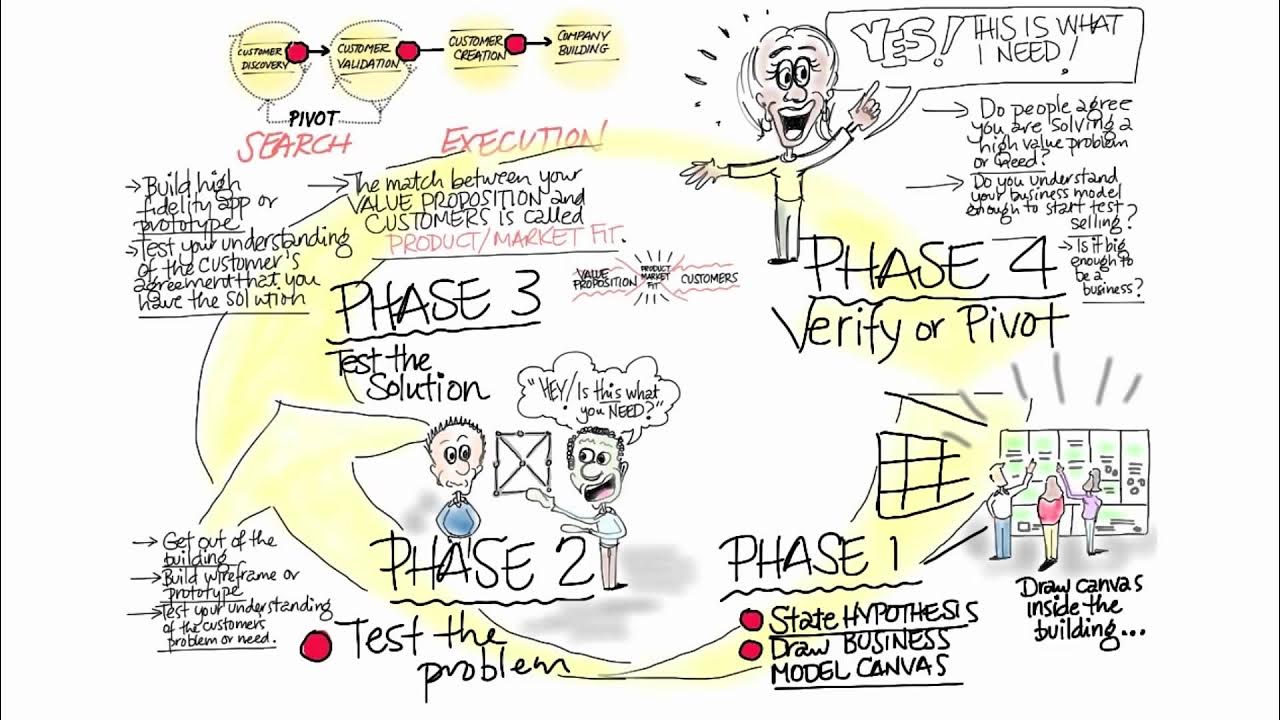The Customer Development Process. 2 Minutes to See Why
Summary
TLDRThe video discusses the customer development process, starting with a business model canvas hypothesis. It emphasizes the importance of testing assumptions by engaging with customers, partners, and vendors early on, rather than relying on random guesses. The process involves four steps: customer discovery, customer validation, product-market fit, and pivoting when necessary. Once a repeatable, scalable business model is found, companies shift to execution, focusing on scaling through customer creation and building functional organizations for rapid execution. This structured approach aims to eliminate guesswork and guide startups in finding success.
Takeaways
- 📋 The customer development process starts with a business model canvas hypothesis.
- 🟨 Post the canvas on the wall and use sticky notes to outline your hypotheses, as most will be incorrect initially.
- 🚶 Get out of the building to gather real data from customers, partners, and vendors instead of relying on guesses.
- 🧪 Use a structured approach with experiments and tests to validate your assumptions.
- 🔍 The customer development process consists of four steps, with the first being customer discovery.
- 👥 In customer discovery, test if others share the problem or need you identified.
- ✔️ The second step is customer validation, where you see if your solution fits the customer's problem.
- 📊 This process tests product-market fit, searching for a viable business model.
- 🔄 The 'pivot' helps refine your approach when assumptions don't hold up, potentially saving your business.
- 🏢 Once a repeatable and scalable model is found, the focus shifts to customer creation and building the organization for growth and execution.
Q & A
What is the first step in the customer development process?
-The first step in the customer development process is customer discovery, where you construct your hypothesis and get out of the building to test your assumptions about whether others have the same problem or need that you think they have.
Why is the business model canvas important in this process?
-The business model canvas helps you visually map out your hypothesis. By using yellow stickies to represent different elements, it allows for flexibility in adjusting and revising assumptions, which is critical because most assumptions will likely be incorrect initially.
What is the goal of customer discovery?
-The goal of customer discovery is to test assumptions about customer problems and needs to see if they align with the problem you think exists, and to gather insights through interviews and interactions.
What does 'getting out of the building' mean in this context?
-'Getting out of the building' refers to going out and talking to real customers, partners, and vendors to test your hypothesis in the real world, instead of relying solely on assumptions made in the office.
What is customer validation in the customer development process?
-Customer validation is the process of testing whether your proposed solution actually matches the problem you've identified. It involves checking if your solution meets customer needs and helps in achieving product-market fit.
What is product-market fit?
-Product-market fit is the alignment between the product's features and the customer's needs, meaning that your solution effectively addresses the problem you identified during customer discovery.
What is the significance of a 'pivot' in the customer development process?
-A pivot is a fundamental change to one or more aspects of your business model or strategy. It allows you to adjust your approach based on customer feedback, and it can save your business by redirecting efforts towards a more viable direction.
When do you transition from customer development to execution?
-You transition from customer development to execution once you've found a repeatable and scalable business model. This involves creating end-user demand at scale and building a functional organization focused on rapid execution.
Why are yellow stickies used instead of pens or pencils when working on the business model canvas?
-Yellow stickies are used instead of pens or pencils because they are easy to move and replace. Since many initial assumptions will likely be incorrect, this flexibility is crucial for continuously updating the canvas as new insights are gained.
What is the purpose of running experiments and tests during the customer development process?
-Running experiments and tests helps to validate or disprove the assumptions made in your business model. It ensures that decisions are based on real data and customer feedback rather than guesses, making the process more rigorous and informed.
Outlines

Esta sección está disponible solo para usuarios con suscripción. Por favor, mejora tu plan para acceder a esta parte.
Mejorar ahoraMindmap

Esta sección está disponible solo para usuarios con suscripción. Por favor, mejora tu plan para acceder a esta parte.
Mejorar ahoraKeywords

Esta sección está disponible solo para usuarios con suscripción. Por favor, mejora tu plan para acceder a esta parte.
Mejorar ahoraHighlights

Esta sección está disponible solo para usuarios con suscripción. Por favor, mejora tu plan para acceder a esta parte.
Mejorar ahoraTranscripts

Esta sección está disponible solo para usuarios con suscripción. Por favor, mejora tu plan para acceder a esta parte.
Mejorar ahoraVer Más Videos Relacionados
5.0 / 5 (0 votes)






